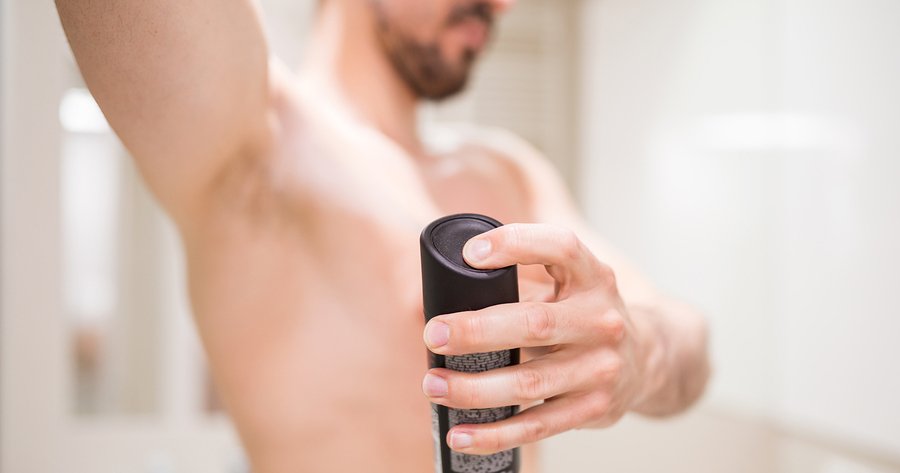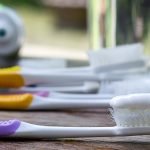WARNING: unbalanced footnote start tag short code found.
If this warning is irrelevant, please disable the syntax validation feature in the dashboard under General settings > Footnote start and end short codes > Check for balanced shortcodes.
Unbalanced start tag short code found before:
“Urban, Julie; et al. “The effect of habitual and experimental antiperspirant and deodorant product use on the armpit microbiome.”
We are taught at a young age that an important part of daily hygiene includes making sure that we smell pleasant to others. A huge industry has been built to address our insecurities in this area, promoting perfumes and colognes, scented body washes and lotions, and soaps of every kind. But possibly the biggest area of concern for many people is their antiperspirant, which can help avoid underarm wetness as well as odor. However, new research suggests that using antiperspirant could be changing the environment of bacteria living around our armpits–what researchers refer to as part of your skin’s microbiome–perhaps with consequences over time.
The study, which took place at the genomics and microbiology research lab of the North Carolina Museum of National Sciences in Raleigh, found that using antiperspirants disrupts the natural colonies of bacteria that reside on the skin of our armpits and unnaturally alters their numbers and species.[fn] Urban, Julie; et al. “The effect of habitual and experimental antiperspirant and deodorant product use on the armpit microbiome.[fn] Urban, Julie; et al. “The effect of habitual and experimental antiperspirant and deodorant product use on the armpit microbiome.” Peer J. 2 February 2016. Accessed 7 February 2016. http://peerj.com/articles/1605/ [/fn] The subjects were 17 men and women who agreed to take part in the trial for an eight-day period. Their use of underarm products varied: seven of the participants applied antiperspirants regularly, five used deodorants instead, and the remaining five employed neither option.
For the first day of the experiment, the scientists had the volunteers stick with their typical habits. Then for the second through sixth days, they had to abstain from using any type of product on their underarms. Finally, for the last two days, every subject applied antiperspirant. Underarm swabs were taken from each of them daily. Not surprisingly, the samples from those who used antiperspirant showed a much smaller number of bacteria than those of the participants who wore deodorant or nothing at all. A less expected twist was that the deodorant wearers had the greatest number of bacteria of all the volunteers.
It’s not clear why deodorant users might have larger bacterial colonies since these products often contain ingredients that can kill off bacteria. However, antiperspirants contain ingredients such as aluminum that actually plug the ducts to prevent wearers from sweating. Since bacteria feed on perspiration, if your body is not producing any in this area, it makes sense that colonies would shrink without it.
On the sixth day of the investigation, when the subjects had to refrain from wearing any underarm products, they all were found to have a similar amount of bacteria present. But the type and diversity of the bacteria differed considerably. The swabs of the participants who reported normally using no underarm products showed 62 percent of their bacteria come from the corynebacteria group and 21 percent from the staphylococcaceae family. In contrast, the vast majority of the bacteria on those who generally use antiperspirant or deodorant come from the staph group, with a much smaller percentage of corynebacteria.
Corynebacteria contribute to body odor, but they have positive effects as well such as providing a defense to the skin from potentially harmful bacteria. Staph, which is well known for causing serious infections particularly if they enter your bloodstream, is usually kept in check on our skin by the other bacteria in your skin’s microbiome. The researchers did not examine which strains of the bacteria were present though, so we don’t know whether the microbe populations were changed for the worse or just altered from use of the underarm products. And this was further demonstrated when on the seventh day of the study all of the volunteers used an antiperspirant and their swabs had a precipitous drop-off in bacterial levels.
While this research is severely limited by the tiny population sample it included, it nevertheless serves as a good reminder that you can’t fool Mother Nature. It’s also probably worth remembering that our skin contains pores that not only allow sweat to come out but also allow our bodies to absorb quite a bit through our skin–including any toxins in your antiperspirants. Parabens, for example, are a common component of not only deodorants, but also cosmetics and even foods. These xenoestrogenic preservatives were shown in a 2012 study at the University of Reading in England to be present in breast cancer tissue.[fn] Barr, L.; et al. “Measurement of paraben concentrations in human breast tissue at serial locations across the breast from axilla to sternum.” Journal of Applied Toxicology. 12 January 2012. Accessed 8 February 2016. http://onlinelibrary.wiley.com/doi/10.1002/jat.1786/abstract [/fn]
It would be wonderful if scientists could build on this foundation to determine whether these underarm products are truly harmful or just one small factor of many environmental risks. Until that time, most people are likely going to be unwilling to give up their antiperspirant and embrace potential body odor and underarm wetness. But it might pay to look at the ingredients of the product you’re choosing and select a more natural version containing witch hazel, baking soda, or essential oils, which may be strong enough to help fight odor but not detrimental to your bacterial ecology. Note: crystal deodorants, which are now very popular, do not contain harmful additives, but they are naturally antibacterial, which as we’ve seen, could be a problem.












Why in the heck did you avoid
Why in the heck did you avoid mentioning that antiperspirants main ingredient is aluminum? My degree is in clinical psychology and in the 70’s clinical studies were published elevated levels of aluminum was linked to in those days, senile dementia. Did I miss this? Wow. Since then much research has been done on other hazards of this heavy metal.
That is simply because this
That is simply because this short news article is about a study on bacteria. We discuss aluminum in antiperspirants at length in many other articles, especially in Jon Barron’s book and his biweekly reports. You should sign up for our newsletters if you like longer, more complete reports on health topics.
I stopped wearing deodorant
I stopped wearing deodorant/antiperspirant(s) a few years ago. I changed my diet to real food for health reasons and noticed after some time I didn’t really smell anymore when I sweated. But, I have noticed that when I do indulge in too much processed imitation food that I smell when I sweat. That stink is the body purging all those chemicals from the imitation food.
As for the sweating, I’d rather have sweaty armpits than increase my chances of breast cancer and other skin disorders. The body sweats for a reason – to cool off and purge toxins. Why are we so intent on stopping this processes? Because it looks and smells nicer? The trade-off isn’t worth it…
I find spray-on magnesium oil
I find spray-on magnesium oil pretty effective even here in Australia although I’m only moderately active. I use it twice a week so a bottle of the Ancient Minerals version lasts me almost a year.